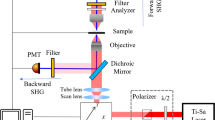Abstract
THERE is controversy over whether axonal elongation is the result of a pulling growth cone and the role of tension in axonal elongationl-4. Earlier in this decade, the consensus was that axons or neurites elongated from tension generated by forward motility of the growth cone5,6. It was presumed that contractile filopodia were the source of the tension moving the growth cone7,8. But this view was challenged by experiments showing that neurites elongate, albeit abnormally, in the presence of cytochalasin, which inhibits growth-cone and filopodial movements9. Additionally, high resol-ution, video-enhanced observations of growth-cone activity argued against filopodial shortening as a source of tension, suggesting instead that an extrusion of cytoplasm rather than a pulling process, is the key event in neurite elongation1,3. Studies of slow axonal transport10, however, indicate that much slower cytoskeletal pushing underlies axonal elongation. We report here direct measurements of neurite force as a function of growth-cone advance which show that they are linearly related and accompanied by apparent neurite growth. No increase in force occurs in neurites whose growth cone fails to advance.
Similar content being viewed by others
References
Aletta, J. M. & Greene, L. A. J. Neurosci. 8, 1425–1435 (1988).
Bray, D. Trends Neurosci. 10, 431–434 (1987).
Goldberg, D. J. & Burmeister, D. W. J. Cell Biol. 103, 1921–1931 (1986).
Letourneau, P. C., Shattuck, T. A. & Ressler, A. H. Cell Motil. Cytoskeleton 8, 193–209 (1987).
Landis, S. C. A. Rev. Physiol. 45, 567–580 (1983).
Letourneau, P. C. in: Neuronal Development (ed. Spitzer, N. C.) (Plenum, New York, 1982).
Bray, D. in: Cell Behavior (ed. Bellair, R., Curtis, A. & Dunn; G.) (Cambridge University Press, 1982).
Trinkaus, J. P. J. Neurosci. Res. 13, 1–19 (1985).
Marsh, L. & Letourneau, P. C. J. Cell Biol. 99, 2061–2067 (1984).
Lasek, R. J. J. Cell Sci. suppl. 5, 161–179 (1986).
Dennerll, T. J., Joshi H. C., Steel, V. L., Buxbaum, R. E. & Heidemann, S. R. J. Cell Biol. 107, 665–674 (1988).
Katz, M. J., George, E. B. & Gilbert, L. J. Cell Motilil. 4, 351–370 (1984).
Bray, D. Devl Biol. 102, 379–389 (1984).
Spero, D. A. & Roisen, F. J. Devl Brain Res. 23, 155–159 (1985).
Buxbaum, R. E. & Heidemann, S. R. J. theor. Biol. 134, 379–390 (1988).
Bray, D. & White, J. G. Science 239, 883–888 (1988).
Forscher, P. & Smith, S. J. J. Cell Biol. 107, 1505–1516 (1988).
Mitchison, T. & Kirschner, M. Neuron 1, 761–772 (1988).
Baas, P. W. & Heidemann, S. R. J. Cell Biol. 103, 917–927 (1986).
Yoneda, M. J. exp. Biol. 37, 461–468 (1960).
Author information
Authors and Affiliations
Rights and permissions
About this article
Cite this article
Lamoureux, P., Buxbaum, R. & Heidemann, S. Direct evidence that growth cones pull. Nature 340, 159–162 (1989). https://doi.org/10.1038/340159a0
Received:
Accepted:
Issue Date:
DOI: https://doi.org/10.1038/340159a0
- Springer Nature Limited
This article is cited by
-
Mathematical models of neuronal growth
Biomechanics and Modeling in Mechanobiology (2022)
-
Axonal cytomechanics in neuronal development
Journal of Biosciences (2020)
-
The model of local axon homeostasis - explaining the role and regulation of microtubule bundles in axon maintenance and pathology
Neural Development (2019)
-
Coupled circumferential and axial tension driven by actin and myosin influences in vivo axon diameter
Scientific Reports (2017)
-
Neurite elongation is highly correlated with bulk forward translocation of microtubules
Scientific Reports (2017)





